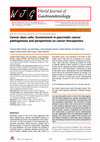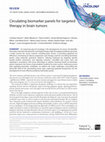Papers by Ana-Maria Enciu

Journal of Alzheimer's disease: JAD
Recently, the blood-brain barrier (BBB) has been pointed to as an active player in neurodegenerat... more Recently, the blood-brain barrier (BBB) has been pointed to as an active player in neurodegenerative disorders, albeit the actual succession of pathogenic events remains to be elucidated. Amyloid-β (Aβ) is an important pathogenic player in Alzheimer's disease, and it is cleared from the brain partly by transportation across the BBB. In this work we asked the question whether Aβ-induced alteration of tight junction (TJ) protein expression is a result of the complex in situ microenvironment of the BBB or if it can be replicated in an externalized environment, such as an in vitro epithelial barrier, where barrier property changes can be investigated without confounding factors. Therefore, we treated barrier forming MDCKI and II epithelial cells with Aβ42 and investigated TJ occludin and claudin-2 protein levels and cellular distribution through western blot and immunofluorescence. To assess barrier function, we measured transepithelial resistance (TEER) and studied cell polarity th...

Recent Patents on Biomarkers, 2015
ABSTRACT Cancer Stem Cells (CSC) comprise a concept proposed in the 1990s in hematopoietic cancer... more ABSTRACT Cancer Stem Cells (CSC) comprise a concept proposed in the 1990s in hematopoietic cancers. These cells were considered, by similitude to normal stem cells, to constitute a small pool of self-renewing cells able to maintain a tumor. Due to their quiescence, CSC would be able to avoid chemotherapeutics targeting fast proliferation rates, or radiotherapy, thus being responsible for tumour relapse. Since CSCs have also been implicated in invasion and metastasis and epithelial to mesenchymal transition (EMT) was proposed as a determinant of malignancy in epithelial cancers, the relationship between EMT and CSC is an important issue, which has been increasingly addressed in recent patents on CSC biology. A thorough search for a more accurate identification of these cells, as well as more effective drug search yielded a number of interesting research patents during the last 5 years, several of which are to be detailed in the present review.

Mechanisms of Ageing and Development, 2015
Ageing is a cellular process with many facets, some of which are currently undergoing a paradigm ... more Ageing is a cellular process with many facets, some of which are currently undergoing a paradigm change. It is the case of "mitochondrial theory of ageing", which, interestingly, has been found lately to cross paths with another ageing dysfunctional process - intracellular signalling - in an unexpected point (or place) - caveolae. The latter represent membrane microdomains altered in senescent cells, scaffolded by proteins modified (posttranslational or as expression) with ageing. An important determinant of these alterations is oxidative stress, through increased production of reactive oxygen species that originate at mitochondrial site. Spanning from physical contact points, to shared structural proteins and similar function domains, caveolae and mitochondria might have more in common than originally thought. By reviewing recent data on oxidative stress impact on caveolae and caveolins, as well as possible interactions between caveolae and mitochondria, we propose a hypothesis for senescence-related involvement of caveolins.
Journal of Aging Research, 2011
Vascular dementia is, in its current conceptual form, a distinct type of dementia with a spectrum... more Vascular dementia is, in its current conceptual form, a distinct type of dementia with a spectrum of specific clinical and pathophysiological features. However, in a very large majority of cases, these alterations occur in an already aged brain, characterized by a milieu of cellular and molecular events common for different neurodegenerative diseases. The cell signaling defects and molecular dyshomeostasis might lead to neuronal malfunction prior to the death of neurons and the alteration of neuronal networks. In the present paper, we explore some of the molecular mechanisms underlying brain malfunction triggered by cerebrovascular disease and risk factors. We suggest that, in the age of genetic investigation and molecular diagnosis, the concept of vascular dementia needs a new approach.

BioMed Research International, 2013
Neuroinflammation is a constant event in Alzheimer's disease (AD), but the current knowledge is i... more Neuroinflammation is a constant event in Alzheimer's disease (AD), but the current knowledge is insufficient to state whether inflammation is a cause, a promoter, or simply a secondary phenomenon in this inexorably progressive ailment. In the current paper, we review research data showing that inflammation is not a prerequisite for onset of dementia, and, although it may worsen the course of the disease, recent evidence shows that chronic inhibition of inflammatory pathways is not necessarily beneficial for patients. Prospective clinical trials with anti-inflammatory drugs failed to stop disease progression, measurements of inflammatory markers in serum and cerebrospinal fluid of patients yielded contradictory results, and recent bench research proved undoubtedly that neuroinflammation has a protective side as well. Knockout animal models for TNFRs or ILRs do not seem to prevent the pathology or the cognitive decline, but quite the contrary. In AD, the therapeutic intervention on inflammatory pathways still has a research future, but its targets probably need reevaluation.

World Journal of Gastroenterology, 2014
Pancreatic cancer is one of the most aggressive and lethal malignancies. Despite remarkable progr... more Pancreatic cancer is one of the most aggressive and lethal malignancies. Despite remarkable progress in understanding pancreatic carcinogenesis at the molecular level, as well as progress in new therapeutic approaches, pancreatic cancer remains a disease with a dismal prognosis. Among the mechanisms responsible for drug resistance, the most relevant are changes in individual genes or signaling pathways and the presence of highly resistant cancer stem cells (CSCs). In pancreatic cancer, CSCs represent 0.2%-0.8% of pancreatic cancer cells and are considered to be responsible for tumor growth, invasion, metastasis and recurrence. CSCs have been extensively studied as of late to identify specific surface markers to ensure reliable sorting and for signaling pathways identified to play a pivotal role in CSC self-renewal. Involvement of CSCs in pancreatic cancer pathogenesis has also highlighted these cells as the preferential targets for therapy. The present review is an update of the results in two main fields of research in pancreatic cancer, pathogenesis and therapy, focused on the narrow perspective of CSCs.

Current Proteomics, 2013
High grade gliomas represent one of the most aggressive and treatment-resistant types of human ca... more High grade gliomas represent one of the most aggressive and treatment-resistant types of human cancer, with only 1-2 years median survival rate for patients with grade IV glioma. The treatment of glioblastoma is a considerable therapeutic challenge; combination therapy targeting multiple pathways is becoming a fast growing area of research. This review offers an up-to-date perspective of the literature about current molecular therapy targets in high grade glioma, that include angiogenic signals, tyrosine kinase receptors, nodal signaling proteins and cancer stem cells related approaches. Simultaneous identification of proteomic signatures could provide biomarker panels for diagnostic and personalized treatment of different subsets of glioblastoma. Personalized medicine is starting to gain importance in clinical care, already having recorded a series of successes in several types of cancer; nonetheless, in brain tumors it is still at an early stage.

Oxidative Medicine and Cellular Longevity, 2013
Neuroinflammation is a constant event in Alzheimer's disease (AD), but the current knowledge is i... more Neuroinflammation is a constant event in Alzheimer's disease (AD), but the current knowledge is insufficient to state whether inflammation is a cause, a promoter, or simply a secondary phenomenon in this inexorably progressive ailment. In the current paper, we review research data showing that inflammation is not a prerequisite for onset of dementia, and, although it may worsen the course of the disease, recent evidence shows that chronic inhibition of inflammatory pathways is not necessarily beneficial for patients. Prospective clinical trials with anti-inflammatory drugs failed to stop disease progression, measurements of inflammatory markers in serum and cerebrospinal fluid of patients yielded contradictory results, and recent bench research proved undoubtedly that neuroinflammation has a protective side as well. Knockout animal models for TNFRs or ILRs do not seem to prevent the pathology or the cognitive decline, but quite the contrary. In AD, the therapeutic intervention on inflammatory pathways still has a research future, but its targets probably need reevaluation.

Future Oncology, 2014
An important goal of oncology is the development of cancer risk-identifier biomarkers that aid ea... more An important goal of oncology is the development of cancer risk-identifier biomarkers that aid early detection and target therapy. High-throughput profiling represents a major concern for cancer research, including brain tumors. A promising approach for efficacious monitoring of disease progression and therapy could be circulating biomarker panels using molecular proteomic patterns. Tailoring treatment by targeting specific protein-protein interactions and signaling networks, microRNA and cancer stem cell signaling in accordance with tumor phenotype or patient clustering based on biomarker panels represents the future of personalized medicine for brain tumors. Gathering current data regarding biomarker candidates, we address the major challenges surrounding the biomarker field of this devastating tumor type, exploring potential perspectives for the development of more effective predictive biomarker panels.
Personalized Medicine, 2013

Proteome Science, 2014
Background: The rapid progress of proteomics over the past years has allowed the discovery of a l... more Background: The rapid progress of proteomics over the past years has allowed the discovery of a large number of potential biomarker candidates to improve early tumor diagnosis and therapeutic response, thus being further integrated into clinical environment. High grade gliomas represent one of the most aggressive and treatment-resistant types of human brain cancer, with approximately 9-12 months median survival rate for patients with grade IV glioma (glioblastoma). Using state-of-the-art proteomics technologies, we have investigated the proteome profile for glioblastoma patients in order to identify a novel protein biomarker panel that could discriminate glioblastoma patients from controls and increase diagnostic accuracy. Results: In this study, SELDI-ToF MS technology was used to screen potential protein patterns in glioblastoma patients serum; furthermore, LC-MS/MS technology was applied to identify the candidate biomarkers peaks. Through these proteomic approaches, three proteins S100A8, S100A9 and CXCL4 were selected as putative biomarkers and confirmed by ELISA. Next step was to validate the above mentioned molecules as biomarkers through identification of protein expression by Western blot in tumoral versus peritumoral tissue. Conclusions: Proteomic technologies have been used to investigate the protein profile of glioblastoma patients and established several potential diagnostic biomarkers. While it is unlikely for a single biomarker to be highly effective for glioblastoma diagnostic, our data proposed an alternative and efficient approach by using a novel combination of multiple biomarkers.

Molecular Biology Reports, 2012
microRNAs are short, non-coding RNAs, that exert a posttranscriptional control on protein synthes... more microRNAs are short, non-coding RNAs, that exert a posttranscriptional control on protein synthesis by mRNA interference. They are involved in normal and pathological embryologic development, as well as in adult life pathology, from myocardial infarction to cancer. There are several brain-specific species of microRNA, showing time-dependent pattern of expression, selectivity for neuronal population, significant roles in correct cellular differentiation and system development. The growing interest in microRNAs extended also in the area of neurodegeneration, some of brain-restricted microRNAs being reported to associate with disorders such as Alzheimer's disease, Parkinson's disease or Huntington's disease. The microRNAs research in the last 3 years offered a considerable amount of information that needs to be integrated in the vast machinery of cellular biology.
BMC Neurology, 2011
Background: Neuroregeneration is a relatively recent concept that includes neurogenesis, neuropla... more Background: Neuroregeneration is a relatively recent concept that includes neurogenesis, neuroplasticity, and neurorestoration -implantation of viable cells as a therapeutical approach.
OncoTargets and Therapy, 2013











Uploads
Papers by Ana-Maria Enciu